Analysis of Vehicle Insurance Brokerage Services: MIS770 Report
VerifiedAdded on 2022/11/29
|9
|2256
|470
Report
AI Summary
This report provides a detailed analysis of vehicle insurance brokerage services based on a given dataset. The analysis includes an executive summary outlining key findings, such as the average yearly savings on vehicle insurance premiums, which was determined to be $230.24. The report investigates the performance of individual brokers, customer satisfaction levels, and factors influencing insurance premiums. Statistical methods, including descriptive analysis, pivot tables, chi-tests, and regression analysis, were employed to derive meaningful insights. The findings reveal variations in customer satisfaction between urban and rural dwellers, and identify vehicle value as a significant factor affecting premium costs. Furthermore, the report estimates the average yearly savings for all customers and approximates the proportion of loss-making clients. The analysis also examines claims regarding the decline in savings over the past two years and the proportion of male users of brokerage services. The report concludes with a memorandum summarizing the analysis and its implications, providing valuable insights for understanding the vehicle insurance brokerage market and its impact on consumers.
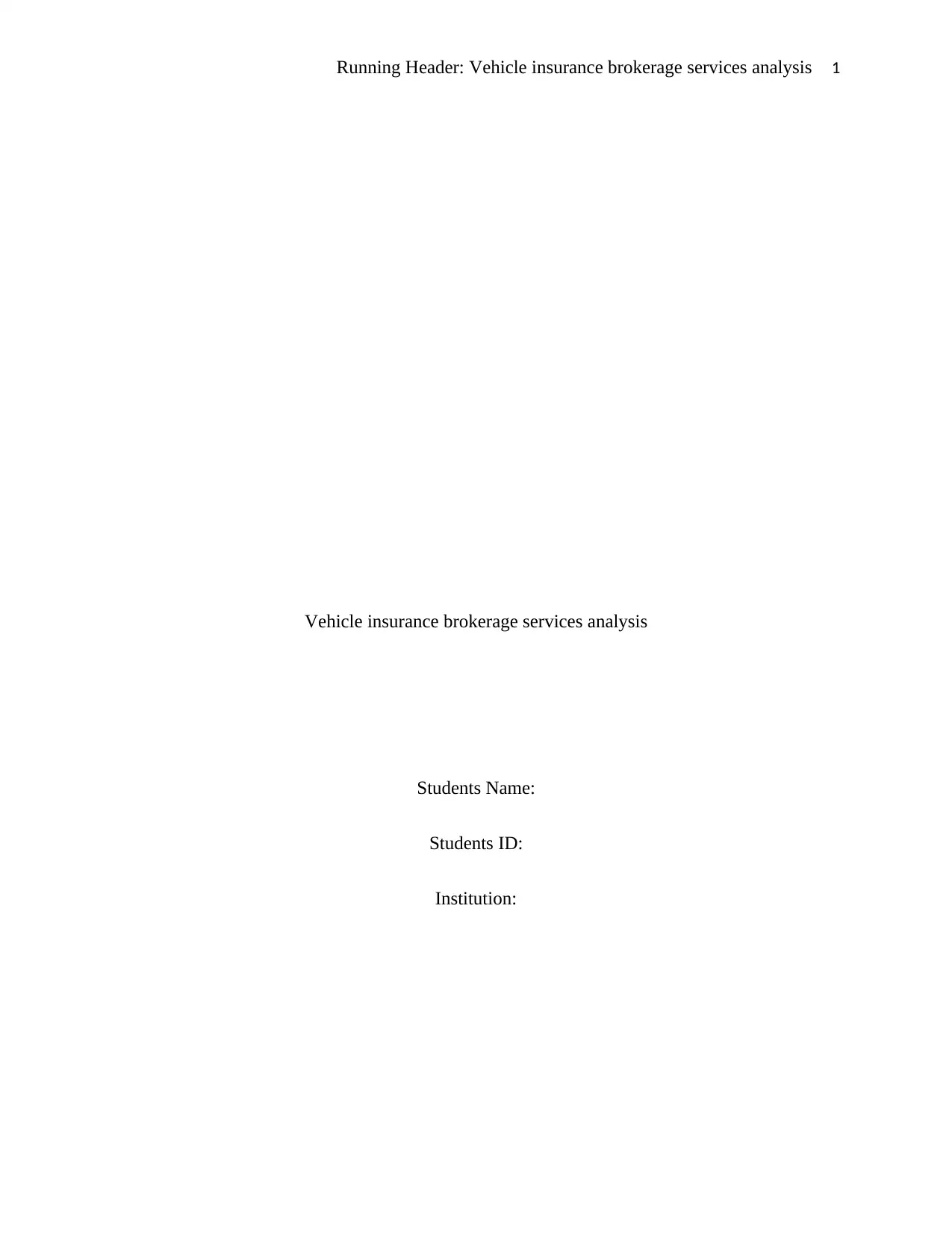
Running Header: Vehicle insurance brokerage services analysis 1
Vehicle insurance brokerage services analysis
Students Name:
Students ID:
Institution:
Vehicle insurance brokerage services analysis
Students Name:
Students ID:
Institution:
Paraphrase This Document
Need a fresh take? Get an instant paraphrase of this document with our AI Paraphraser
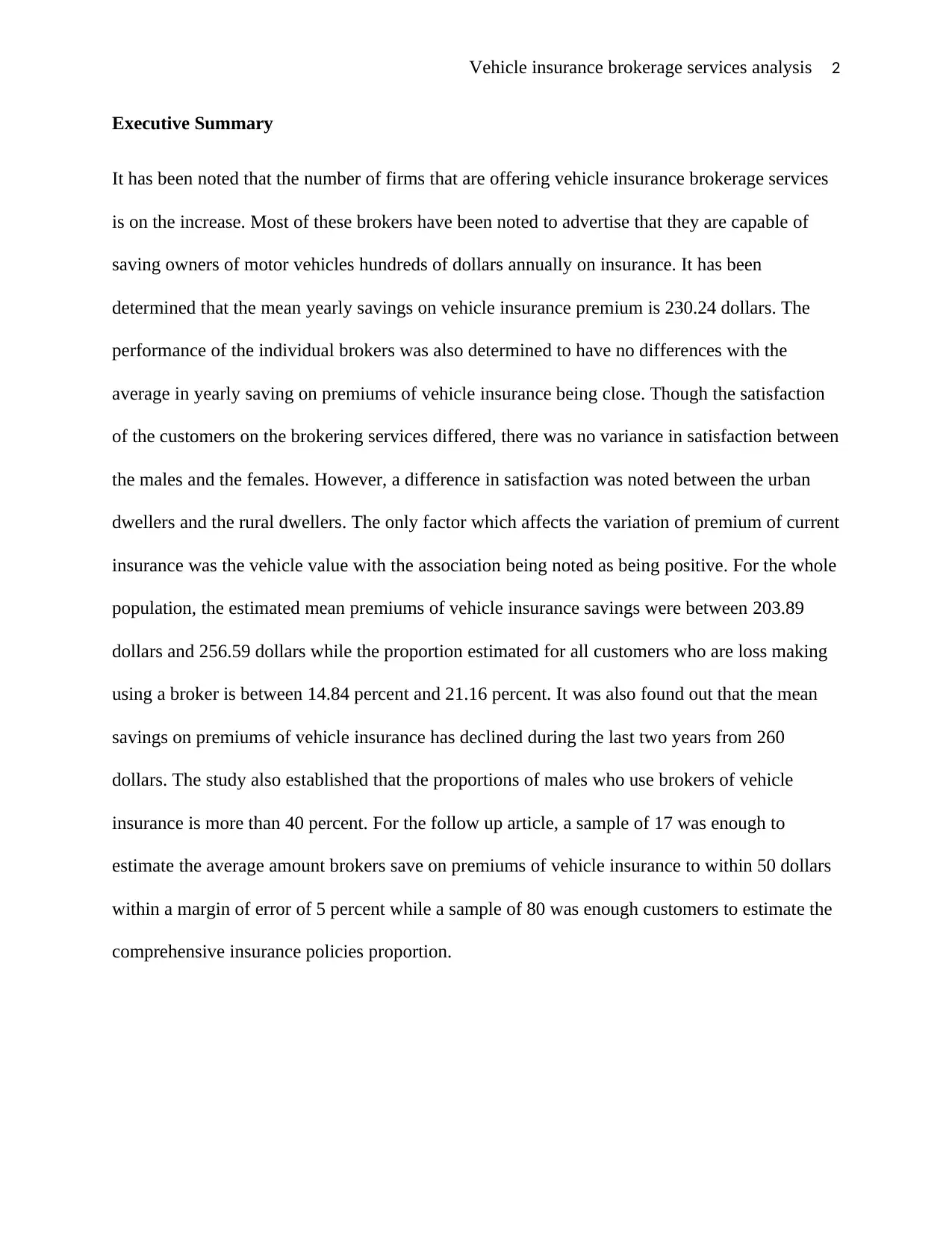
Vehicle insurance brokerage services analysis 2
Executive Summary
It has been noted that the number of firms that are offering vehicle insurance brokerage services
is on the increase. Most of these brokers have been noted to advertise that they are capable of
saving owners of motor vehicles hundreds of dollars annually on insurance. It has been
determined that the mean yearly savings on vehicle insurance premium is 230.24 dollars. The
performance of the individual brokers was also determined to have no differences with the
average in yearly saving on premiums of vehicle insurance being close. Though the satisfaction
of the customers on the brokering services differed, there was no variance in satisfaction between
the males and the females. However, a difference in satisfaction was noted between the urban
dwellers and the rural dwellers. The only factor which affects the variation of premium of current
insurance was the vehicle value with the association being noted as being positive. For the whole
population, the estimated mean premiums of vehicle insurance savings were between 203.89
dollars and 256.59 dollars while the proportion estimated for all customers who are loss making
using a broker is between 14.84 percent and 21.16 percent. It was also found out that the mean
savings on premiums of vehicle insurance has declined during the last two years from 260
dollars. The study also established that the proportions of males who use brokers of vehicle
insurance is more than 40 percent. For the follow up article, a sample of 17 was enough to
estimate the average amount brokers save on premiums of vehicle insurance to within 50 dollars
within a margin of error of 5 percent while a sample of 80 was enough customers to estimate the
comprehensive insurance policies proportion.
Executive Summary
It has been noted that the number of firms that are offering vehicle insurance brokerage services
is on the increase. Most of these brokers have been noted to advertise that they are capable of
saving owners of motor vehicles hundreds of dollars annually on insurance. It has been
determined that the mean yearly savings on vehicle insurance premium is 230.24 dollars. The
performance of the individual brokers was also determined to have no differences with the
average in yearly saving on premiums of vehicle insurance being close. Though the satisfaction
of the customers on the brokering services differed, there was no variance in satisfaction between
the males and the females. However, a difference in satisfaction was noted between the urban
dwellers and the rural dwellers. The only factor which affects the variation of premium of current
insurance was the vehicle value with the association being noted as being positive. For the whole
population, the estimated mean premiums of vehicle insurance savings were between 203.89
dollars and 256.59 dollars while the proportion estimated for all customers who are loss making
using a broker is between 14.84 percent and 21.16 percent. It was also found out that the mean
savings on premiums of vehicle insurance has declined during the last two years from 260
dollars. The study also established that the proportions of males who use brokers of vehicle
insurance is more than 40 percent. For the follow up article, a sample of 17 was enough to
estimate the average amount brokers save on premiums of vehicle insurance to within 50 dollars
within a margin of error of 5 percent while a sample of 80 was enough customers to estimate the
comprehensive insurance policies proportion.
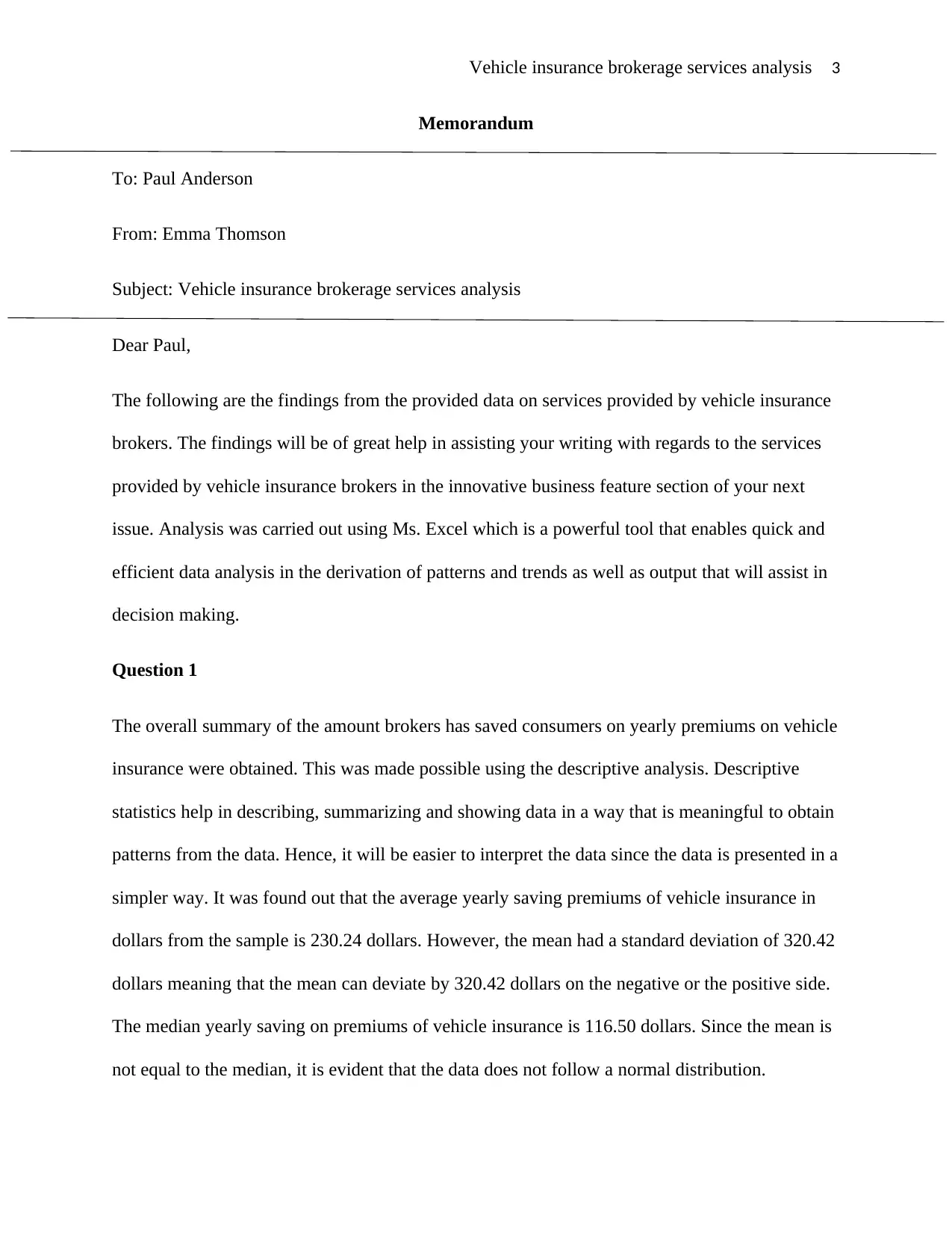
Vehicle insurance brokerage services analysis 3
Memorandum
To: Paul Anderson
From: Emma Thomson
Subject: Vehicle insurance brokerage services analysis
Dear Paul,
The following are the findings from the provided data on services provided by vehicle insurance
brokers. The findings will be of great help in assisting your writing with regards to the services
provided by vehicle insurance brokers in the innovative business feature section of your next
issue. Analysis was carried out using Ms. Excel which is a powerful tool that enables quick and
efficient data analysis in the derivation of patterns and trends as well as output that will assist in
decision making.
Question 1
The overall summary of the amount brokers has saved consumers on yearly premiums on vehicle
insurance were obtained. This was made possible using the descriptive analysis. Descriptive
statistics help in describing, summarizing and showing data in a way that is meaningful to obtain
patterns from the data. Hence, it will be easier to interpret the data since the data is presented in a
simpler way. It was found out that the average yearly saving premiums of vehicle insurance in
dollars from the sample is 230.24 dollars. However, the mean had a standard deviation of 320.42
dollars meaning that the mean can deviate by 320.42 dollars on the negative or the positive side.
The median yearly saving on premiums of vehicle insurance is 116.50 dollars. Since the mean is
not equal to the median, it is evident that the data does not follow a normal distribution.
Memorandum
To: Paul Anderson
From: Emma Thomson
Subject: Vehicle insurance brokerage services analysis
Dear Paul,
The following are the findings from the provided data on services provided by vehicle insurance
brokers. The findings will be of great help in assisting your writing with regards to the services
provided by vehicle insurance brokers in the innovative business feature section of your next
issue. Analysis was carried out using Ms. Excel which is a powerful tool that enables quick and
efficient data analysis in the derivation of patterns and trends as well as output that will assist in
decision making.
Question 1
The overall summary of the amount brokers has saved consumers on yearly premiums on vehicle
insurance were obtained. This was made possible using the descriptive analysis. Descriptive
statistics help in describing, summarizing and showing data in a way that is meaningful to obtain
patterns from the data. Hence, it will be easier to interpret the data since the data is presented in a
simpler way. It was found out that the average yearly saving premiums of vehicle insurance in
dollars from the sample is 230.24 dollars. However, the mean had a standard deviation of 320.42
dollars meaning that the mean can deviate by 320.42 dollars on the negative or the positive side.
The median yearly saving on premiums of vehicle insurance is 116.50 dollars. Since the mean is
not equal to the median, it is evident that the data does not follow a normal distribution.
⊘ This is a preview!⊘
Do you want full access?
Subscribe today to unlock all pages.

Trusted by 1+ million students worldwide
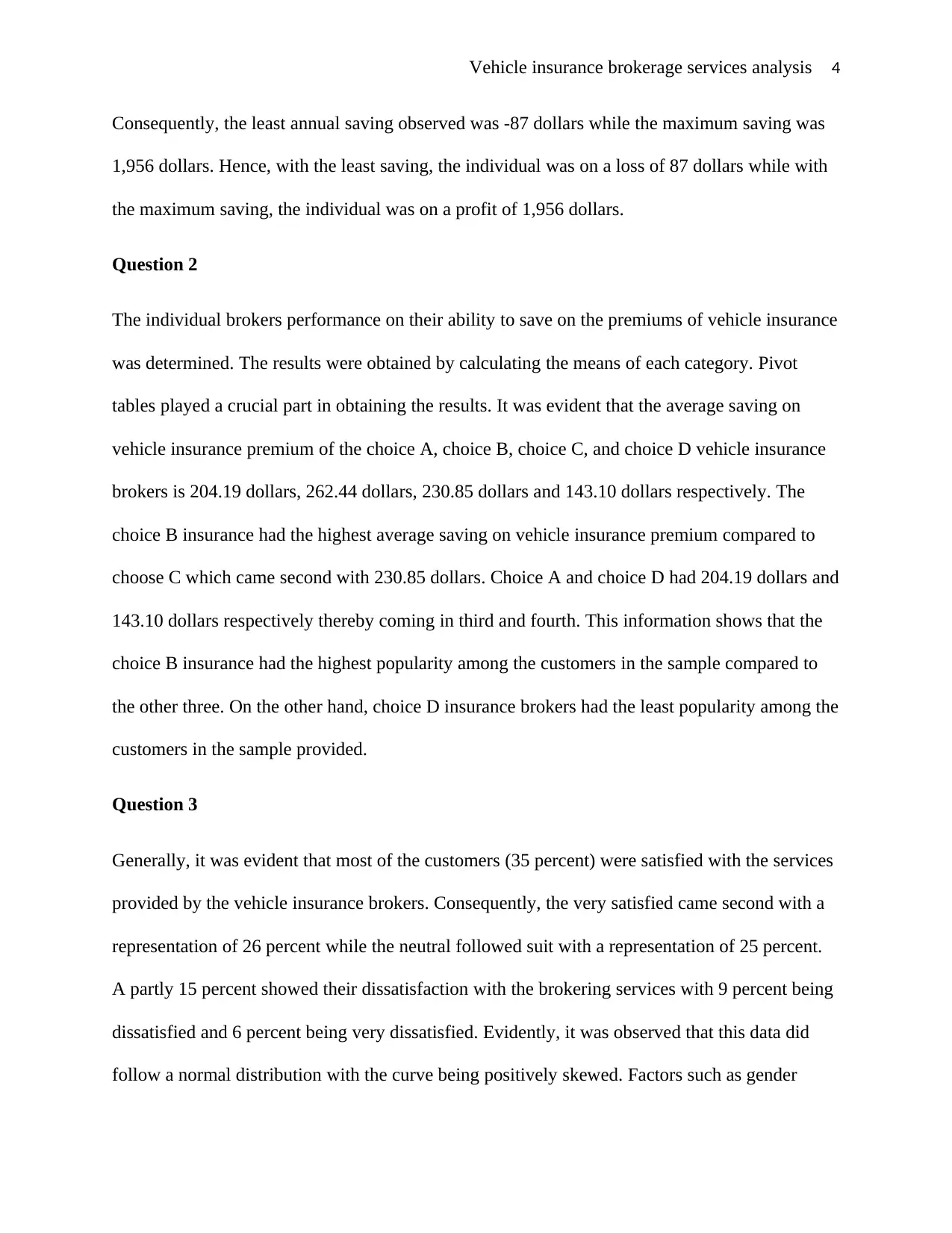
Vehicle insurance brokerage services analysis 4
Consequently, the least annual saving observed was -87 dollars while the maximum saving was
1,956 dollars. Hence, with the least saving, the individual was on a loss of 87 dollars while with
the maximum saving, the individual was on a profit of 1,956 dollars.
Question 2
The individual brokers performance on their ability to save on the premiums of vehicle insurance
was determined. The results were obtained by calculating the means of each category. Pivot
tables played a crucial part in obtaining the results. It was evident that the average saving on
vehicle insurance premium of the choice A, choice B, choice C, and choice D vehicle insurance
brokers is 204.19 dollars, 262.44 dollars, 230.85 dollars and 143.10 dollars respectively. The
choice B insurance had the highest average saving on vehicle insurance premium compared to
choose C which came second with 230.85 dollars. Choice A and choice D had 204.19 dollars and
143.10 dollars respectively thereby coming in third and fourth. This information shows that the
choice B insurance had the highest popularity among the customers in the sample compared to
the other three. On the other hand, choice D insurance brokers had the least popularity among the
customers in the sample provided.
Question 3
Generally, it was evident that most of the customers (35 percent) were satisfied with the services
provided by the vehicle insurance brokers. Consequently, the very satisfied came second with a
representation of 26 percent while the neutral followed suit with a representation of 25 percent.
A partly 15 percent showed their dissatisfaction with the brokering services with 9 percent being
dissatisfied and 6 percent being very dissatisfied. Evidently, it was observed that this data did
follow a normal distribution with the curve being positively skewed. Factors such as gender
Consequently, the least annual saving observed was -87 dollars while the maximum saving was
1,956 dollars. Hence, with the least saving, the individual was on a loss of 87 dollars while with
the maximum saving, the individual was on a profit of 1,956 dollars.
Question 2
The individual brokers performance on their ability to save on the premiums of vehicle insurance
was determined. The results were obtained by calculating the means of each category. Pivot
tables played a crucial part in obtaining the results. It was evident that the average saving on
vehicle insurance premium of the choice A, choice B, choice C, and choice D vehicle insurance
brokers is 204.19 dollars, 262.44 dollars, 230.85 dollars and 143.10 dollars respectively. The
choice B insurance had the highest average saving on vehicle insurance premium compared to
choose C which came second with 230.85 dollars. Choice A and choice D had 204.19 dollars and
143.10 dollars respectively thereby coming in third and fourth. This information shows that the
choice B insurance had the highest popularity among the customers in the sample compared to
the other three. On the other hand, choice D insurance brokers had the least popularity among the
customers in the sample provided.
Question 3
Generally, it was evident that most of the customers (35 percent) were satisfied with the services
provided by the vehicle insurance brokers. Consequently, the very satisfied came second with a
representation of 26 percent while the neutral followed suit with a representation of 25 percent.
A partly 15 percent showed their dissatisfaction with the brokering services with 9 percent being
dissatisfied and 6 percent being very dissatisfied. Evidently, it was observed that this data did
follow a normal distribution with the curve being positively skewed. Factors such as gender
Paraphrase This Document
Need a fresh take? Get an instant paraphrase of this document with our AI Paraphraser
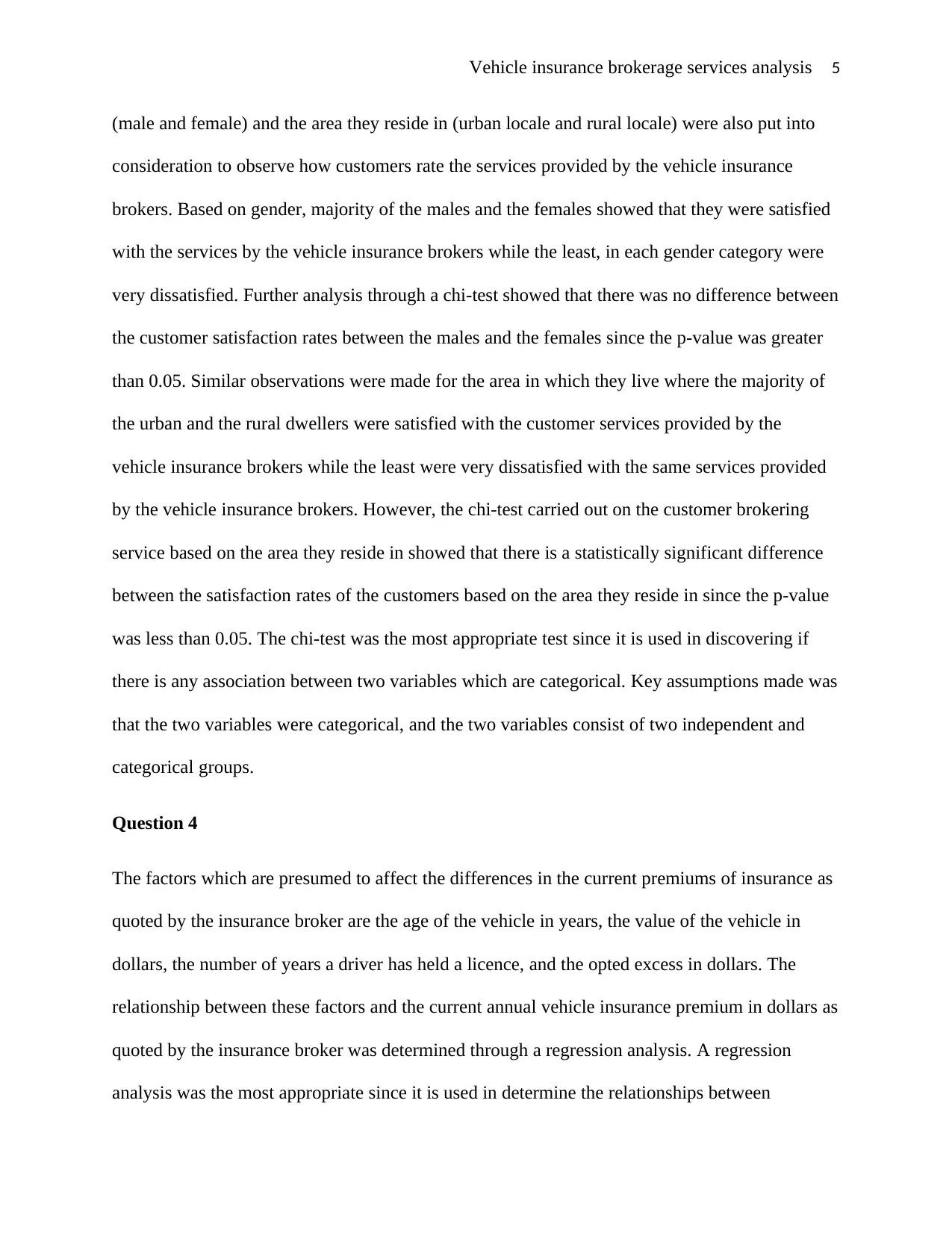
Vehicle insurance brokerage services analysis 5
(male and female) and the area they reside in (urban locale and rural locale) were also put into
consideration to observe how customers rate the services provided by the vehicle insurance
brokers. Based on gender, majority of the males and the females showed that they were satisfied
with the services by the vehicle insurance brokers while the least, in each gender category were
very dissatisfied. Further analysis through a chi-test showed that there was no difference between
the customer satisfaction rates between the males and the females since the p-value was greater
than 0.05. Similar observations were made for the area in which they live where the majority of
the urban and the rural dwellers were satisfied with the customer services provided by the
vehicle insurance brokers while the least were very dissatisfied with the same services provided
by the vehicle insurance brokers. However, the chi-test carried out on the customer brokering
service based on the area they reside in showed that there is a statistically significant difference
between the satisfaction rates of the customers based on the area they reside in since the p-value
was less than 0.05. The chi-test was the most appropriate test since it is used in discovering if
there is any association between two variables which are categorical. Key assumptions made was
that the two variables were categorical, and the two variables consist of two independent and
categorical groups.
Question 4
The factors which are presumed to affect the differences in the current premiums of insurance as
quoted by the insurance broker are the age of the vehicle in years, the value of the vehicle in
dollars, the number of years a driver has held a licence, and the opted excess in dollars. The
relationship between these factors and the current annual vehicle insurance premium in dollars as
quoted by the insurance broker was determined through a regression analysis. A regression
analysis was the most appropriate since it is used in determine the relationships between
(male and female) and the area they reside in (urban locale and rural locale) were also put into
consideration to observe how customers rate the services provided by the vehicle insurance
brokers. Based on gender, majority of the males and the females showed that they were satisfied
with the services by the vehicle insurance brokers while the least, in each gender category were
very dissatisfied. Further analysis through a chi-test showed that there was no difference between
the customer satisfaction rates between the males and the females since the p-value was greater
than 0.05. Similar observations were made for the area in which they live where the majority of
the urban and the rural dwellers were satisfied with the customer services provided by the
vehicle insurance brokers while the least were very dissatisfied with the same services provided
by the vehicle insurance brokers. However, the chi-test carried out on the customer brokering
service based on the area they reside in showed that there is a statistically significant difference
between the satisfaction rates of the customers based on the area they reside in since the p-value
was less than 0.05. The chi-test was the most appropriate test since it is used in discovering if
there is any association between two variables which are categorical. Key assumptions made was
that the two variables were categorical, and the two variables consist of two independent and
categorical groups.
Question 4
The factors which are presumed to affect the differences in the current premiums of insurance as
quoted by the insurance broker are the age of the vehicle in years, the value of the vehicle in
dollars, the number of years a driver has held a licence, and the opted excess in dollars. The
relationship between these factors and the current annual vehicle insurance premium in dollars as
quoted by the insurance broker was determined through a regression analysis. A regression
analysis was the most appropriate since it is used in determine the relationships between
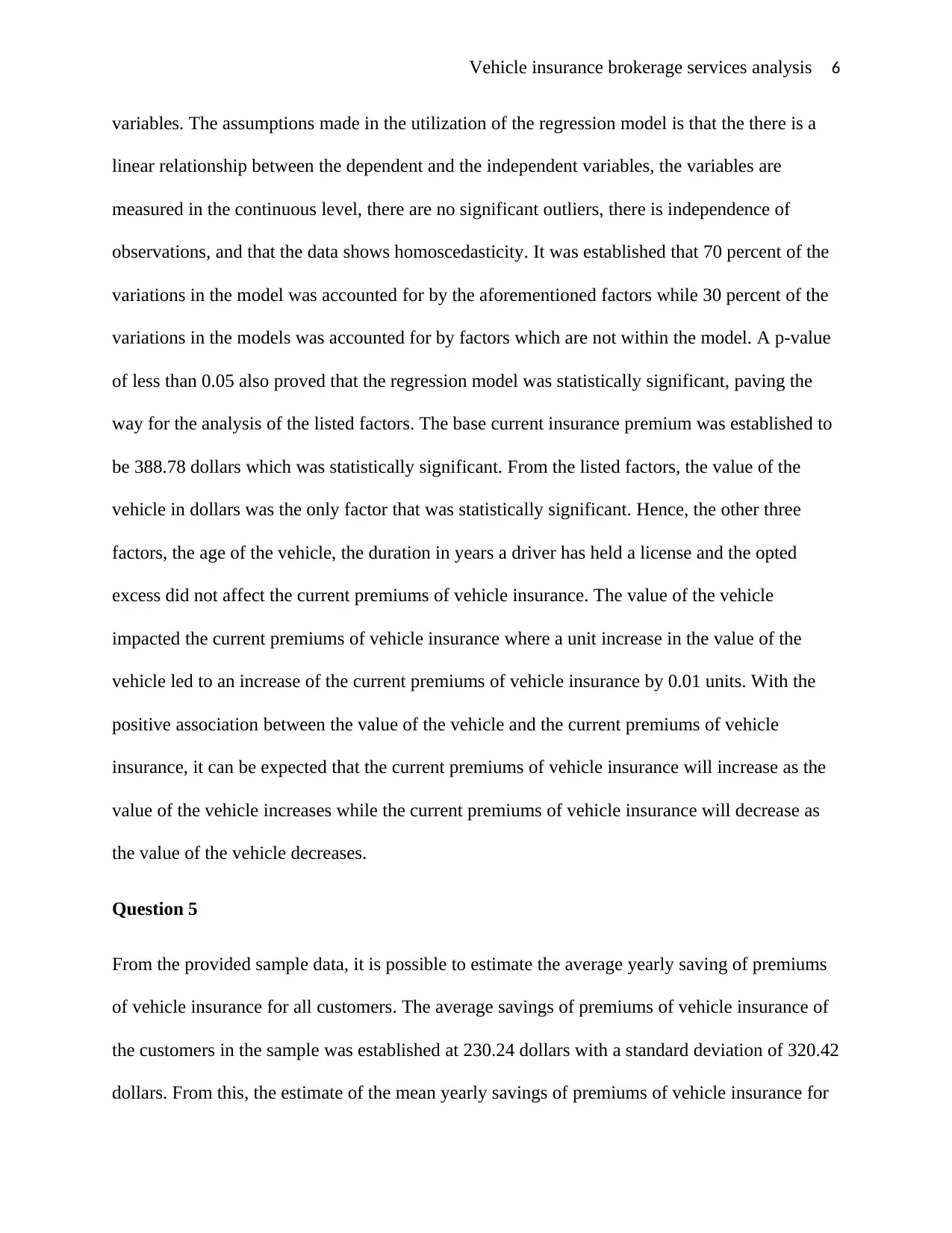
Vehicle insurance brokerage services analysis 6
variables. The assumptions made in the utilization of the regression model is that the there is a
linear relationship between the dependent and the independent variables, the variables are
measured in the continuous level, there are no significant outliers, there is independence of
observations, and that the data shows homoscedasticity. It was established that 70 percent of the
variations in the model was accounted for by the aforementioned factors while 30 percent of the
variations in the models was accounted for by factors which are not within the model. A p-value
of less than 0.05 also proved that the regression model was statistically significant, paving the
way for the analysis of the listed factors. The base current insurance premium was established to
be 388.78 dollars which was statistically significant. From the listed factors, the value of the
vehicle in dollars was the only factor that was statistically significant. Hence, the other three
factors, the age of the vehicle, the duration in years a driver has held a license and the opted
excess did not affect the current premiums of vehicle insurance. The value of the vehicle
impacted the current premiums of vehicle insurance where a unit increase in the value of the
vehicle led to an increase of the current premiums of vehicle insurance by 0.01 units. With the
positive association between the value of the vehicle and the current premiums of vehicle
insurance, it can be expected that the current premiums of vehicle insurance will increase as the
value of the vehicle increases while the current premiums of vehicle insurance will decrease as
the value of the vehicle decreases.
Question 5
From the provided sample data, it is possible to estimate the average yearly saving of premiums
of vehicle insurance for all customers. The average savings of premiums of vehicle insurance of
the customers in the sample was established at 230.24 dollars with a standard deviation of 320.42
dollars. From this, the estimate of the mean yearly savings of premiums of vehicle insurance for
variables. The assumptions made in the utilization of the regression model is that the there is a
linear relationship between the dependent and the independent variables, the variables are
measured in the continuous level, there are no significant outliers, there is independence of
observations, and that the data shows homoscedasticity. It was established that 70 percent of the
variations in the model was accounted for by the aforementioned factors while 30 percent of the
variations in the models was accounted for by factors which are not within the model. A p-value
of less than 0.05 also proved that the regression model was statistically significant, paving the
way for the analysis of the listed factors. The base current insurance premium was established to
be 388.78 dollars which was statistically significant. From the listed factors, the value of the
vehicle in dollars was the only factor that was statistically significant. Hence, the other three
factors, the age of the vehicle, the duration in years a driver has held a license and the opted
excess did not affect the current premiums of vehicle insurance. The value of the vehicle
impacted the current premiums of vehicle insurance where a unit increase in the value of the
vehicle led to an increase of the current premiums of vehicle insurance by 0.01 units. With the
positive association between the value of the vehicle and the current premiums of vehicle
insurance, it can be expected that the current premiums of vehicle insurance will increase as the
value of the vehicle increases while the current premiums of vehicle insurance will decrease as
the value of the vehicle decreases.
Question 5
From the provided sample data, it is possible to estimate the average yearly saving of premiums
of vehicle insurance for all customers. The average savings of premiums of vehicle insurance of
the customers in the sample was established at 230.24 dollars with a standard deviation of 320.42
dollars. From this, the estimate of the mean yearly savings of premiums of vehicle insurance for
⊘ This is a preview!⊘
Do you want full access?
Subscribe today to unlock all pages.

Trusted by 1+ million students worldwide
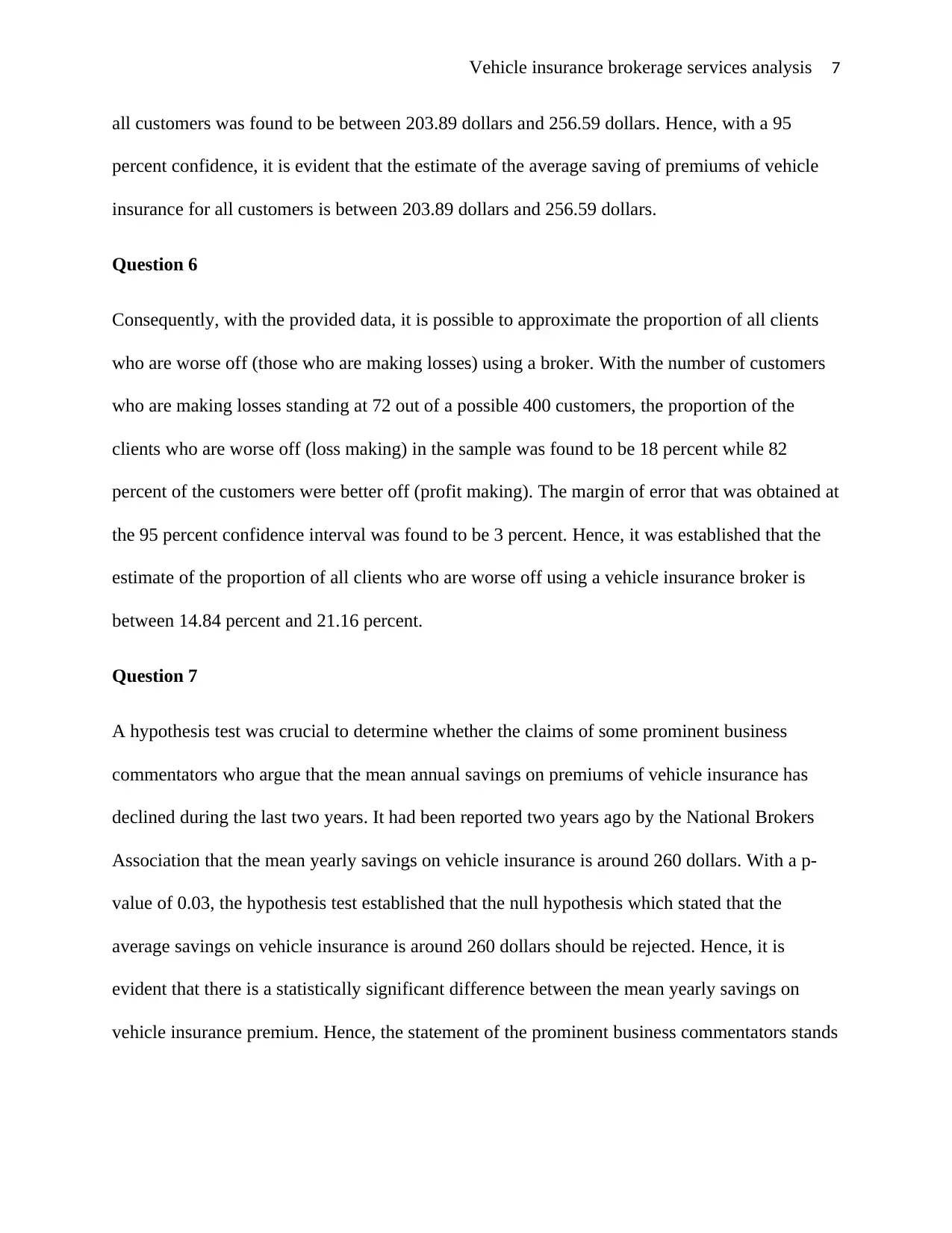
Vehicle insurance brokerage services analysis 7
all customers was found to be between 203.89 dollars and 256.59 dollars. Hence, with a 95
percent confidence, it is evident that the estimate of the average saving of premiums of vehicle
insurance for all customers is between 203.89 dollars and 256.59 dollars.
Question 6
Consequently, with the provided data, it is possible to approximate the proportion of all clients
who are worse off (those who are making losses) using a broker. With the number of customers
who are making losses standing at 72 out of a possible 400 customers, the proportion of the
clients who are worse off (loss making) in the sample was found to be 18 percent while 82
percent of the customers were better off (profit making). The margin of error that was obtained at
the 95 percent confidence interval was found to be 3 percent. Hence, it was established that the
estimate of the proportion of all clients who are worse off using a vehicle insurance broker is
between 14.84 percent and 21.16 percent.
Question 7
A hypothesis test was crucial to determine whether the claims of some prominent business
commentators who argue that the mean annual savings on premiums of vehicle insurance has
declined during the last two years. It had been reported two years ago by the National Brokers
Association that the mean yearly savings on vehicle insurance is around 260 dollars. With a p-
value of 0.03, the hypothesis test established that the null hypothesis which stated that the
average savings on vehicle insurance is around 260 dollars should be rejected. Hence, it is
evident that there is a statistically significant difference between the mean yearly savings on
vehicle insurance premium. Hence, the statement of the prominent business commentators stands
all customers was found to be between 203.89 dollars and 256.59 dollars. Hence, with a 95
percent confidence, it is evident that the estimate of the average saving of premiums of vehicle
insurance for all customers is between 203.89 dollars and 256.59 dollars.
Question 6
Consequently, with the provided data, it is possible to approximate the proportion of all clients
who are worse off (those who are making losses) using a broker. With the number of customers
who are making losses standing at 72 out of a possible 400 customers, the proportion of the
clients who are worse off (loss making) in the sample was found to be 18 percent while 82
percent of the customers were better off (profit making). The margin of error that was obtained at
the 95 percent confidence interval was found to be 3 percent. Hence, it was established that the
estimate of the proportion of all clients who are worse off using a vehicle insurance broker is
between 14.84 percent and 21.16 percent.
Question 7
A hypothesis test was crucial to determine whether the claims of some prominent business
commentators who argue that the mean annual savings on premiums of vehicle insurance has
declined during the last two years. It had been reported two years ago by the National Brokers
Association that the mean yearly savings on vehicle insurance is around 260 dollars. With a p-
value of 0.03, the hypothesis test established that the null hypothesis which stated that the
average savings on vehicle insurance is around 260 dollars should be rejected. Hence, it is
evident that there is a statistically significant difference between the mean yearly savings on
vehicle insurance premium. Hence, the statement of the prominent business commentators stands
Paraphrase This Document
Need a fresh take? Get an instant paraphrase of this document with our AI Paraphraser
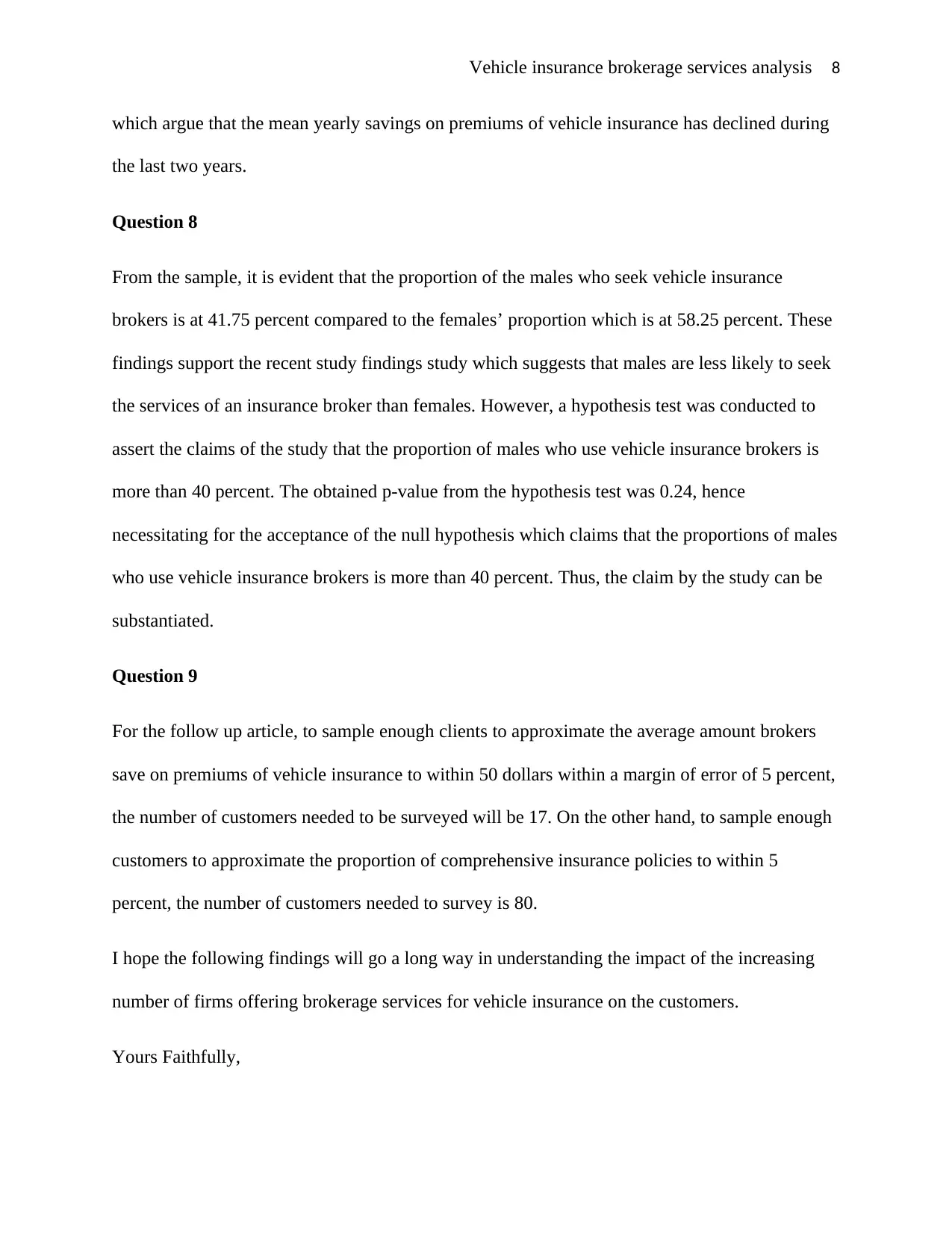
Vehicle insurance brokerage services analysis 8
which argue that the mean yearly savings on premiums of vehicle insurance has declined during
the last two years.
Question 8
From the sample, it is evident that the proportion of the males who seek vehicle insurance
brokers is at 41.75 percent compared to the females’ proportion which is at 58.25 percent. These
findings support the recent study findings study which suggests that males are less likely to seek
the services of an insurance broker than females. However, a hypothesis test was conducted to
assert the claims of the study that the proportion of males who use vehicle insurance brokers is
more than 40 percent. The obtained p-value from the hypothesis test was 0.24, hence
necessitating for the acceptance of the null hypothesis which claims that the proportions of males
who use vehicle insurance brokers is more than 40 percent. Thus, the claim by the study can be
substantiated.
Question 9
For the follow up article, to sample enough clients to approximate the average amount brokers
save on premiums of vehicle insurance to within 50 dollars within a margin of error of 5 percent,
the number of customers needed to be surveyed will be 17. On the other hand, to sample enough
customers to approximate the proportion of comprehensive insurance policies to within 5
percent, the number of customers needed to survey is 80.
I hope the following findings will go a long way in understanding the impact of the increasing
number of firms offering brokerage services for vehicle insurance on the customers.
Yours Faithfully,
which argue that the mean yearly savings on premiums of vehicle insurance has declined during
the last two years.
Question 8
From the sample, it is evident that the proportion of the males who seek vehicle insurance
brokers is at 41.75 percent compared to the females’ proportion which is at 58.25 percent. These
findings support the recent study findings study which suggests that males are less likely to seek
the services of an insurance broker than females. However, a hypothesis test was conducted to
assert the claims of the study that the proportion of males who use vehicle insurance brokers is
more than 40 percent. The obtained p-value from the hypothesis test was 0.24, hence
necessitating for the acceptance of the null hypothesis which claims that the proportions of males
who use vehicle insurance brokers is more than 40 percent. Thus, the claim by the study can be
substantiated.
Question 9
For the follow up article, to sample enough clients to approximate the average amount brokers
save on premiums of vehicle insurance to within 50 dollars within a margin of error of 5 percent,
the number of customers needed to be surveyed will be 17. On the other hand, to sample enough
customers to approximate the proportion of comprehensive insurance policies to within 5
percent, the number of customers needed to survey is 80.
I hope the following findings will go a long way in understanding the impact of the increasing
number of firms offering brokerage services for vehicle insurance on the customers.
Yours Faithfully,
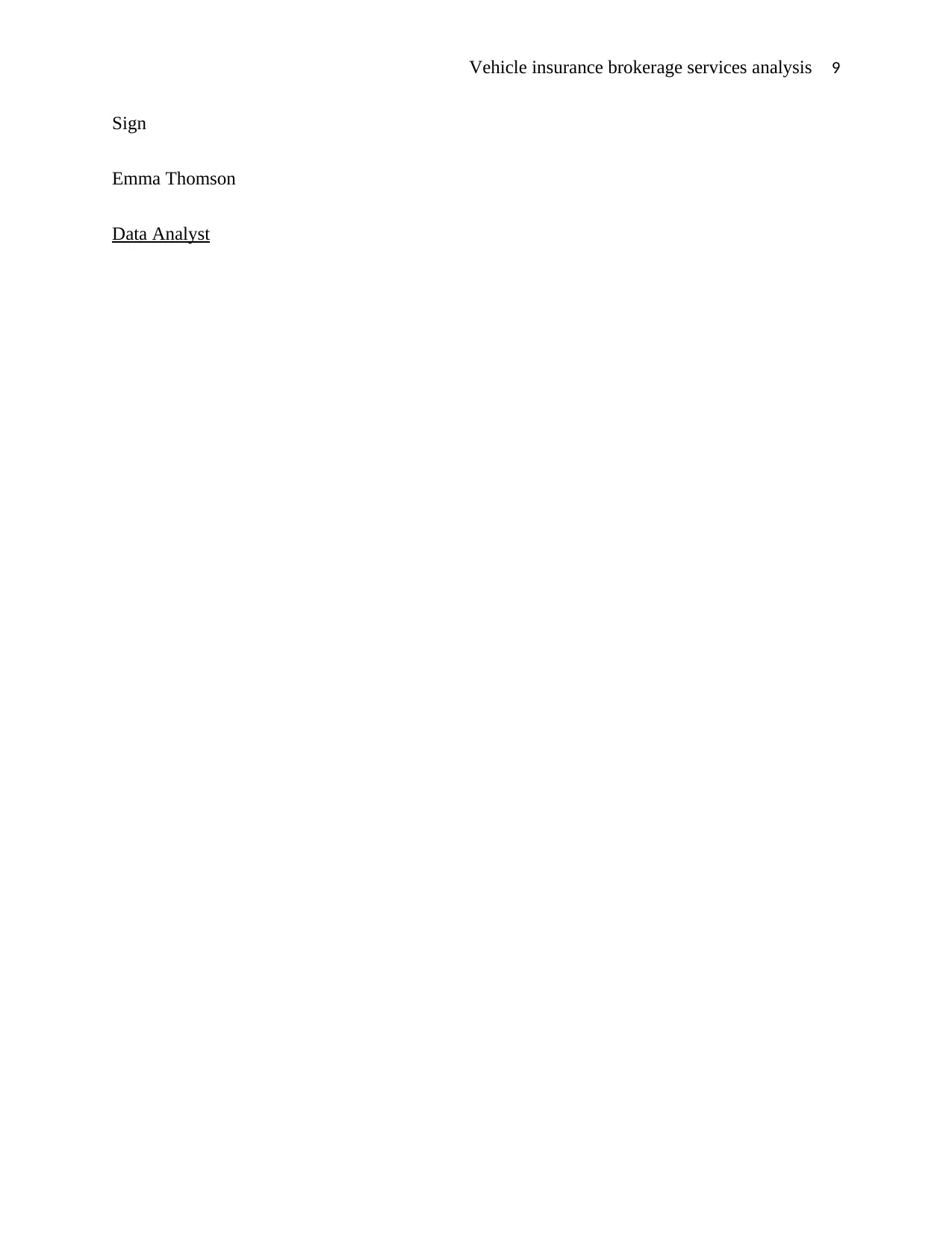
Vehicle insurance brokerage services analysis 9
Sign
Emma Thomson
Data Analyst
Sign
Emma Thomson
Data Analyst
⊘ This is a preview!⊘
Do you want full access?
Subscribe today to unlock all pages.

Trusted by 1+ million students worldwide
1 out of 9
Related Documents
Your All-in-One AI-Powered Toolkit for Academic Success.
+13062052269
info@desklib.com
Available 24*7 on WhatsApp / Email
![[object Object]](/_next/static/media/star-bottom.7253800d.svg)
Unlock your academic potential
Copyright © 2020–2025 A2Z Services. All Rights Reserved. Developed and managed by ZUCOL.





